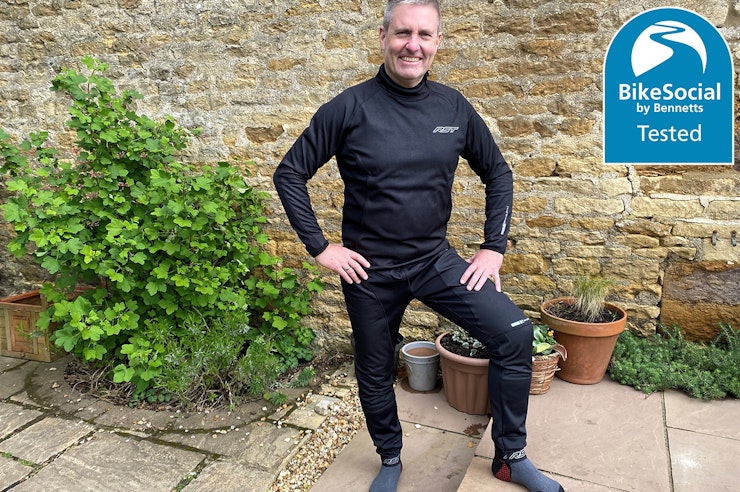RST Thermal WindBlock base layers review | Gilet, long-sleeve and pants tested
By BikeSocial Member
Everyday riders, just like you...
12.06.2024
Date reviewed: April 2024 | Tested by: Simon Roberts | Price: £49.99-£54.99 | www.rst-moto.com
Effective use of layers can improve both comfort and concentration while riding. For the past eight months I’ve been testing the RST WindBlock Thermal base layers, while riding a BMW R1200GS Adventure and a BMW R1250RT. This review covers the WindBlock Thermal gilet, long-sleeved shirt and pants.
Thin and lightweight
Completely windproof
Retains body heat
Stretchy materials and comfortable fit
Long-sleeve top is challenging to get on and off
Getting the right size is critical
Material and Construction
RST’s WindBlock garments are made from polyester with polyurethane and elastane for added stretch and rapid recovery. The material on the inside is soft and comfortable next to the skin, feeling similar to a very fine fleece. Two materials on the outside that provide stretch – a super-thin neoprene-like material is used in areas generally not subjected to direct wind blast, such as inner and under arms, sides of torso, inside leg. Another technical fabric is used in areas likely to face direct wind, such as chest, shoulders and knees.
Fit and Feel
RST describes these garments as being “crafted with a four-way stretch material that is not only ergonomic but also incorporates stretch and compression properties”.
From my perspective anything that provides a degree of compression needs to be stretchy, and RST’s Wind Block garments are, to a point. However, the material is substantially thicker and much less forgiving than a standard base layer made from synthetic materials or merino wool, so it’s critical to get sizing right to avoid tight spots and discomfort.
The long-sleeve shirt and gilet are available in sizes ranging from S to 3XL with a lot of online buyers reporting that the shirt fits smaller than expected. I’m 5ft 9in, weigh just under 13 stone and a size medium fits me well. Getting the shirt up and over my head is a bit of a fiddle, whereas the gilet is quick and easy to put on.
The WindBlock pants come in waist sizes ranging from S to 3XL (30in-40in), with no choice of leg length. I usually wear trousers in 32in or 34in waist and found the Large (34in) fit me fine, and the thick elastic waistband provides plenty of flexibility.
I wore the long-sleeve shirt either next to the skin or over the top of a t-shirt, or with a super-thin long-sleeve base layer underneath in cold weather. I always wore the pants next to the skin (aside from underwear!) And finally, I wore the gilet over the top of other base layers or a thin fleece. On top I wore a textile jacket and trousers with or without an insulating layer (see below).
Warm and cold weather use
I’ve worn a lot of different base layers over the years, but RST’s WindBlock garments have proven to be something altogether different.
A good base layer wicks moisture away from the skin to make you more comfortable, and at the same time can act as a basic insulating layer when things get chilly.
A thin base layer is not a substantial insulating layer when temperatures seriously drop, so I would normally wear a mid-layers like a jumper, fleece, down layer or a jacket’s thermal liner over the base layer to keep me warm.
However, in temperatures down to 10 degrees Celsius I found the long-sleeved shirt and pants alone kept me perfectly comfortable, with no other insulating layer required. The result was less bulk and a freedom of movement that I usually only experience in warmer weather.
In the case of the long-sleeve shirt I expected it to protect me from the wind and associated wind chill, but I did not expect it to retain body heat. The soft inner lining is partly responsible, but I suspect the (very) close fitting side-zipped collar, elasticated cuffs and hem, and an extended back length also contribute a lot to retaining body heat. The fact I could often ditch bulky mid-layers for my 25-mile commute and longer rides of two-three hours has been fantastic.
In temperatures approaching 20 degrees (warm but not hot) I found myself overheating while wearing the long-sleeve shirt and pants. Wearing the gilet instead was better as this allowed more air to flow and provided only partial wind chill protection, but I feel there are lighter, more breathable options when riding in warm conditions.
Comfort when on and off the bike
I got the sizing right, which meant I was unaware of the RST WindBlock base layers when on and off the bike. The combination of different materials and built-in stretch keep the garments in place and allow for normal freedom of movement in all circumstances. Getting on and off my R1200GS Adventure was no more effort than usual, and walking around town or sitting at a table was fine. However, I feel the substantial construction and close-fitting features would cause discomfort, tightness and restriction issues if sizing was not spot-on.
Washing and care
Some synthetic technical garments require specialist washing products and/or cleaning but not the RST WindBlock base layers. They can go on a 30-degree machine wash with similarly coloured garments, but the label warns not to bleach, dry clean or tumble dry. The label states the garments can be ironed on a low heat setting, but I didn’t risk that.
Three alternatives to the RST WindBlock Thermal base layers
Alternatives range from simple and traditional to more technical and contemporary materials. The RST WindBlock base layers offer something a little different to most, but here are some other options..
Made from back-to-basics synthetic materials, but warm and super-stretchy, the DXR Warmcore base layer top and trousers are excellent value at £14.99 each. Here’s our full review of the DXR Warmcore baselayers.
Merino base layers (using wool from the merino breed of sheep) are the traditionalists’ choice. EDZ offers a good range, but outdoor retailers such as Decathlon or Mountain Warehouse sell merino base layers too.
Catering for ‘adventure motorcyclists’, Adventure Spec markets a range of base layers with flat-locked seams and silver ion yarn for enhanced comfort and to prevent odour build up. Prices range from £29 (shorts) to £99 (long sleeve base layer with pockets for optional armour).
These are just three alternatives – you can find all the motorcycle base layers we’ve tested here and be sure to regularly check for the discounts available through Bikesocial membership.
RST Thermal WindBlock base layers review: Verdict
Over the years I’ve worn both synthetic and merino base layers of varying specifications, largely with no complaints. The RST Wind Block base layers are not a wholesale replacement for either but can add to or complement them depending on circumstances.
In warm conditions (let alone hot), a thin merino or synthetic base layer is still my preferred choice for lightness and maximum breathability.
The RST Wind Block garments are now my preferred option on many rides in cooler temperatures. The windproof specification and heat retention capabilities are welcome and the increased freedom of movement that comes from not having to wear a mid-layer is brilliant.
In cold weather, when heated kit is not an option, I’ve found wearing the RST Wind Block kit over a thin base layer with the usual insulation layer on top makes for a very comfortable combination.
Sizing correctly is critical (more so than with any base layer I’ve ever used), but as a technical addition to an effective layering system, the RST Wind Block base layers offer some serious credentials.
If you’d like to chat about this article or anything else biking related, join us and thousands of other riders at the Bennetts BikeSocial Facebook page.

